How to Grow Daikon Radish: A Complete Cultivation Guide from Seed Selection to Harvest
- March 19, 2024
- 0 comment
Daikon, also known as white radish or Japanese radish, is a popular root vegetable in Asian cuisine, known for its mild flavor and crisp texture. Growing daikon at home can be rewarding and is relatively straightforward if you follow some key steps. This guide will walk you through the process from seed selection to harvest, ensuring you can enjoy fresh, homegrown daikon radishes.

| Benefit | Description |
|---|---|
| Digestive Health | Daikon radish is high in dietary fiber, which aids in digestion and helps prevent constipation. |
| Low in Calories | It is very low in calories, making it an excellent addition to weight loss diets. |
| Rich in Vitamins | Daikon is a good source of Vitamin C, which boosts the immune system, and also contains smaller amounts of Vitamin A and some B vitamins. |
| Antioxidant Properties | Contains antioxidants that help combat free radicals in the body, potentially reducing the risk of chronic diseases. |
| Detoxification | Traditionally believed to have detoxifying properties, helping to cleanse the blood and eliminate toxins from the body. |
| Anti-inflammatory | Some compounds in daikon, such as sulforaphane and indoles, may have anti-inflammatory effects. |
| Supports Heart Health | The fiber, potassium, and antioxidant content in daikon may contribute to cardiovascular health by reducing blood pressure and cholesterol levels. |
| Enhances Skin Health | The high vitamin C content contributes to collagen production, which can improve skin health and appearance. |
| Supports Respiratory Health | Daikon juice is sometimes used in traditional medicine to help clear congested respiratory pathways. |
| Diuretic Properties | Daikon can act as a natural diuretic, helping the body to eliminate excess water and salt, which is beneficial for kidney health and blood pressure. |
List on How To Grow Daikon Radish
- Selecting the Right Variety
- Preparing the Soil
- Sowing Seeds
- Caring for Your Daikon
- Harvesting
- Storing
- Pest and Disease Management
Selecting the Right Variety
Daikon comes in several varieties, differing in size, flavor, and growth duration. For home gardens, choose a variety that suits your climate and taste preferences. Some popular varieties include ‘Miyashige’, ‘Minowase’, and ‘Sakurajima’. Research the specific needs of the variety you choose, as some may require a longer growing season or have particular soil preferences.
Miyashige
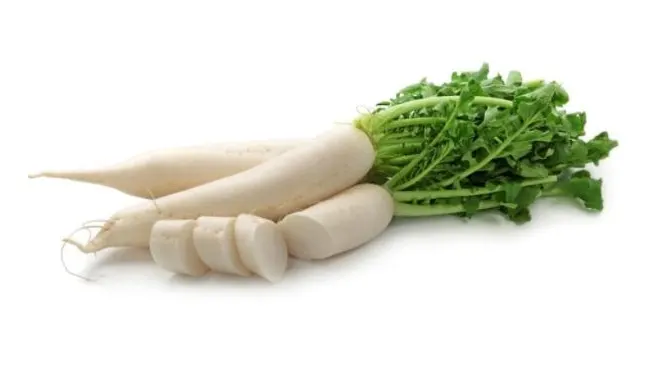
- Description: ‘Miyashige’ is a traditional long white variety known for its sweet and mild flavor. It typically grows up to 18 inches in length and is ideal for pickling, salads, and stir-fries.
- Growth Duration: It has a moderate growth rate, usually ready to harvest in about 50-60 days.
- Climate Adaptability: Performs well in a wide range of climates but prefers cooler weather, making it a great choice for fall planting.
Minowase
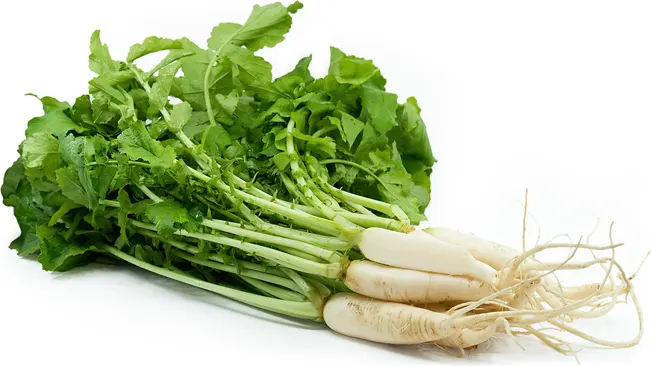
- Description: Also known as ‘Minowase Daikon’, this variety produces large, long, and slender white roots that can grow over 2 feet in length. It has a crisp texture and a mild flavor, making it versatile in the kitchen.
- Growth Duration: ‘Minowase’ requires a slightly longer growing period, typically around 60-70 days to reach maturity.
- Climate Adaptability: It is adaptable to various climates but thrives in cooler conditions, ideal for late summer to early fall planting.
Sakurajima
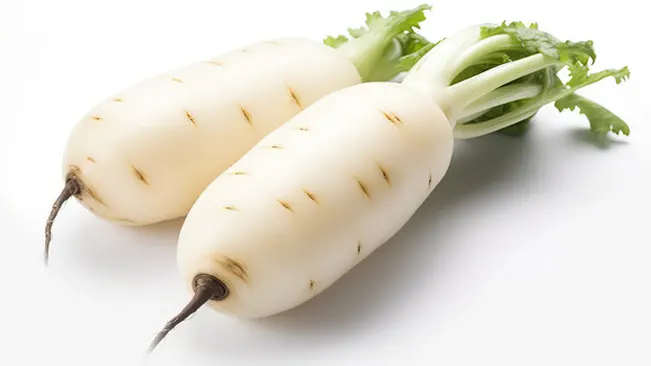
- Description: This is a unique and heirloom variety known for producing large, round radishes that can weigh up to 10 pounds or more. ‘Sakurajima’ has a distinct sweet and spicy flavor profile.
- Growth Duration: Due to its size, ‘Sakurajima’ takes longer to mature, often requiring 70-90 days.
- Climate Adaptability: It prefers cooler temperatures and may not perform as well in very hot climates. It’s best suited for regions with mild winters or for fall planting in cooler areas.
Considerations for Selection
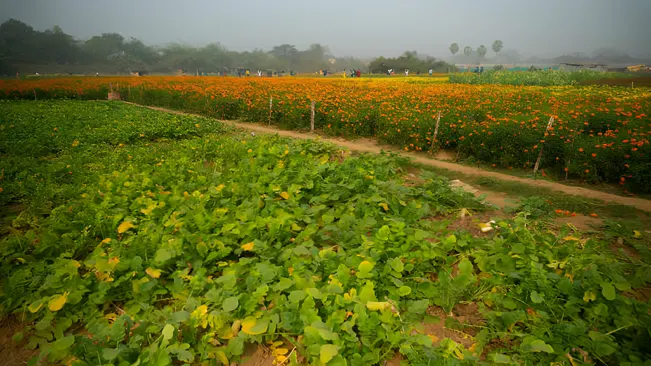
- Climate: Choose a variety that is well-suited to your local climate. Some varieties are more tolerant of heat or cold than others.
- Soil Type: While Daikon radishes are generally adaptable, they prefer loose, well-drained soil. If your soil is heavy clay or sandy, consider varieties that are more tolerant of these conditions or amend your soil accordingly.
- Use: Consider what you want to use your Daikon for. If you’re interested in pickling, you might prefer a longer, slender variety like ‘Miyashige’ or ‘Minowase’. For fresh salads or roasting, ‘Sakurajima’ might provide an interesting variation.
- Space: Larger varieties like ‘Sakurajima’ require more space per plant, so consider your garden’s size when choosing.
Preparing the Soil
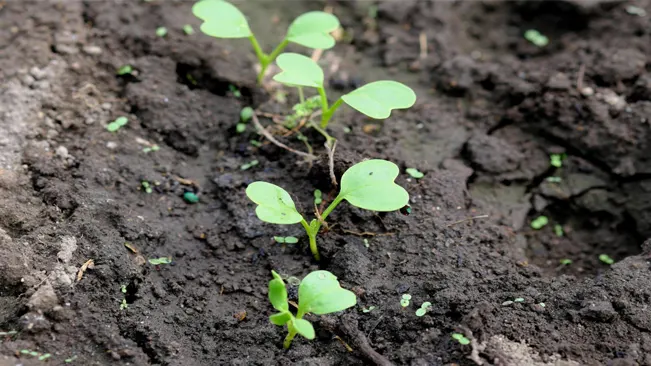
Soil Depth and Texture
- Looseness: Daikon radishes prefer a loose, airy soil structure that allows their roots to penetrate deeply without resistance. Compacted soil can hinder root growth, leading to stunted or misshapen radishes.
- Depth: Tilling or turning the soil to a depth of 12-18 inches is essential. This depth accommodates the length of the Daikon radish roots, which can grow quite long. Deep tilling also helps to aerate the soil, improving its structure and drainage.
Soil Fertility
- Organic Matter: Incorporating plenty of organic matter into the soil is beneficial for several reasons. It improves soil fertility, provides essential nutrients to the plants, helps retain moisture, and enhances the soil’s structure, making it more conducive to root growth.
- Compost and Aged Manure: Adding compost or aged manure enriches the soil with a balanced mix of nutrients. These amendments also introduce beneficial microorganisms that contribute to a healthy soil ecosystem. Ensure that the manure is well-aged to avoid the risk of burning the plants with too much nitrogen or introducing pathogens.
Soil Drainage
- Well-Drained Soil: Good drainage is critical for Daikon radishes to prevent waterlogging, which can lead to root rot. While they need consistent moisture, the soil should allow excess water to drain away quickly.
- Amendments for Drainage: If you have heavy clay soil, consider amending it with sand or fine gravel to improve drainage. Organic matter like compost can also improve the soil’s structure, enhancing its drainage capabilities.
Soil pH
- pH Level: Daikon radishes grow best in soil with a pH level of 6.0 to 7.0. This slightly acidic to neutral range allows the plants to absorb nutrients effectively.
- Testing and Adjusting pH: Before planting, it’s a good idea to test your soil’s pH. If the pH is outside the ideal range, you can adjust it by adding lime to raise the pH or sulfur to lower it. Be sure to follow the instructions on the amendment packaging for the best results.
Sowing Seeds
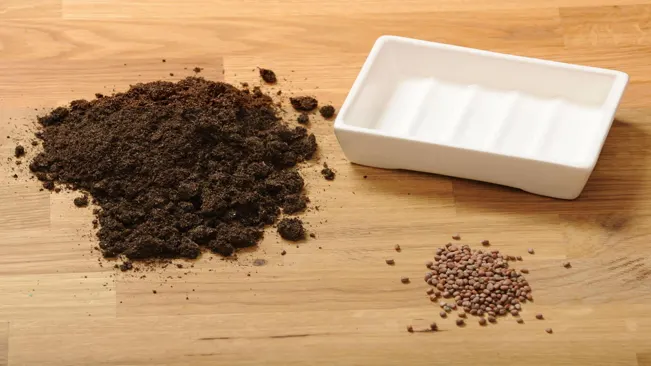
Timing
- Late Summer to Early Fall Planting: This timing allows the Daikon radishes to mature in cooler weather, which is ideal for their development. The cooler temperatures help enhance their flavor and texture. For most temperate climates, this would mean planting in August or September.
- Early Spring Planting: In areas with mild winters or for gardeners looking to get an early start, Daikon can be planted as soon as the soil can be worked in the spring. This might be late winter or early spring, depending on your location.
Soil Preparation
- Before sowing the seeds, ensure the soil is well-prepared. Daikon radishes prefer a loose, well-drained soil rich in organic matter. Since they develop long roots, it’s crucial to break up any compacted soil and remove rocks or debris to a depth of at least 12-18 inches.
- Incorporate plenty of aged compost or well-rotted manure to enrich the soil. This step is vital for providing the necessary nutrients for growth and for improving soil structure and moisture retention.
Sowing the Seeds
- Depth and Spacing: Plant the seeds about ½ inch deep in the soil. This depth is sufficient for them to germinate effectively while being protected from surface disturbances. Space the seeds 2-4 inches apart in rows to give them enough room to start growing without overcrowding.
- Row Spacing: Rows should be spaced 12-18 inches apart. This spacing allows for adequate air circulation around the plants, which is essential for preventing fungal diseases and for making watering, weeding, and harvesting easier.
- Watering: After sowing the seeds, water the area gently but thoroughly. The goal is to moisten the soil without dislodging or burying the seeds too deeply. Consistent moisture is crucial for germination, so keep the soil evenly moist (but not waterlogged) until the seeds sprout.
Caring for Your Daikon
Watering
Daikon radishes require consistent moisture throughout their growth cycle. This consistent moisture is vital for a few reasons:
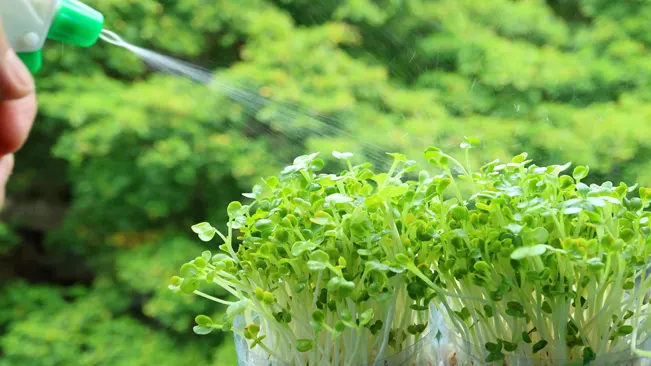
- Steady Growth: Regular watering helps the radishes grow uniformly, preventing irregular shapes.
- Texture and Taste: Adequate water prevents the radishes from developing a woody texture and overly spicy flavor, which can happen if the plant is stressed from drought.
- Avoiding Overwatering: While consistent moisture is important, it’s equally important to avoid waterlogging the soil. Overwatered daikon can suffer from root rot and other fungal diseases. Ensure your soil has good drainage and water when the top inch of soil feels dry to the touch.
Mulching
Applying a layer of mulch around your daikon radishes has several benefits:
- Moisture Retention: Mulch helps the soil retain moisture, reducing the need for frequent watering.
- Weed Suppression: A layer of mulch can suppress weed growth, reducing competition for nutrients and water.
- Temperature Regulation: Mulch helps regulate soil temperature, keeping it cooler in hot weather and warmer during cooler nights.
- Soil Health: Organic mulches, like straw or leaf litter, can break down over time, adding valuable organic matter to the soil.
Thinning
Thinning is the process of removing some plants to give the remaining ones enough space to grow. This is crucial for a few reasons:
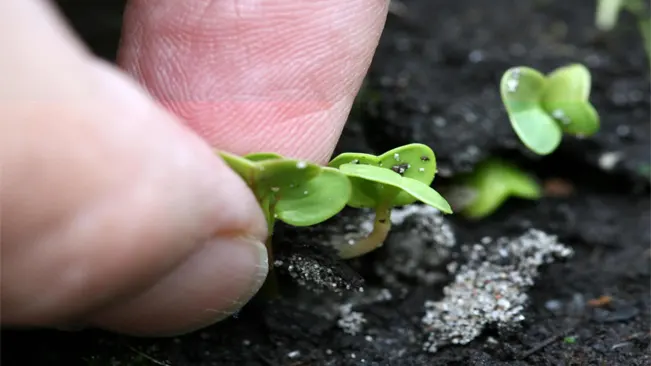
- Space to Grow: Daikon radishes can grow quite large, and overcrowding can hinder their development. Thinning ensures each plant has enough space to grow both above and below the soil.
- Air Circulation: Adequate space between plants promotes better air circulation, which can help reduce the risk of fungal diseases.
- Resource Allocation: Thinning reduces competition for water, nutrients, and light, allowing the remaining plants to thrive.
Harvesting
Timing and Indicators for Harvest

- Maturity Signs: Daikon radishes are generally ready to harvest when the tops of their roots start to protrude above the soil surface. This is a good indicator that they have reached a suitable size beneath the soil. The skin should appear smooth and firm.
- Size: While the exact size at maturity can vary depending on the variety, many Daikon radishes can grow quite large, some reaching up to 18 inches in length and 3 inches in diameter. However, they are often harvested when they are slightly smaller to ensure the best texture and flavor.
- Weather Impact: Cooler weather tends to enhance the flavor of Daikon radishes, making late fall harvests particularly desirable in many regions. If an unexpected warm spell occurs, it might be wise to harvest earlier to avoid a decrease in quality.
Harvesting Technique
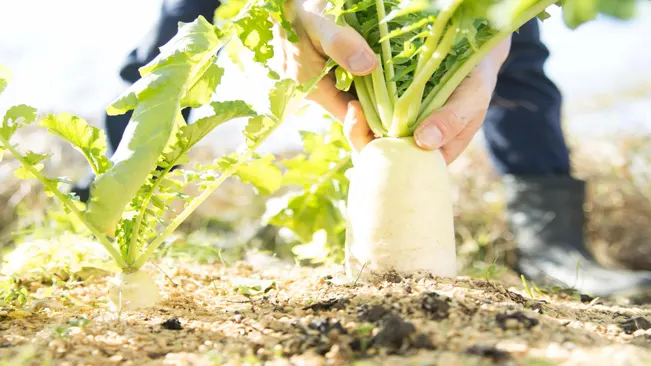
- Loosening the Soil: Use a garden fork or a spade to gently loosen the soil around each Daikon radish. This makes it easier to pull the radish out without damaging it.
- Pulling: Once the soil is loose, grasp the top of the radish near the base of the stems and pull gently. If the radish resists, you may need to loosen the soil further or use the fork to gently lever it out.
- Handling Large Radishes: For particularly large or stubborn Daikon radishes, you may need to dig around the radish more extensively to avoid snapping it off in the ground.
Post-Harvest Handling
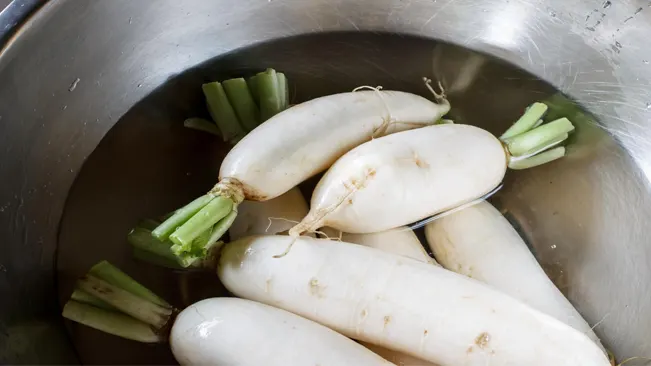
- Cleaning: After harvesting, gently shake off any loose soil and wash the radishes to remove any remaining dirt. Be careful not to damage the skin, as breaks can lead to quicker spoilage.
- Trimming: Trim off the leafy tops if you plan to store the radishes, as the leaves can draw moisture from the root, causing it to lose crispness. However, if you plan to use the radish immediately, the leaves can be left on and are edible, similar to turnip or beet greens.
- Storing: Daikon radishes can be stored in a cool, dark place, such as a refrigerator crisper drawer, for several weeks. Wrapping them in a damp cloth or paper towel and placing them in a plastic bag can help retain moisture and extend their shelf life.
Storing
After harvesting, remove the leaves and store the roots in a cool, dark place, like a refrigerator or root cellar. Daikon can keep for several weeks if stored properly.
Short-Term Storage
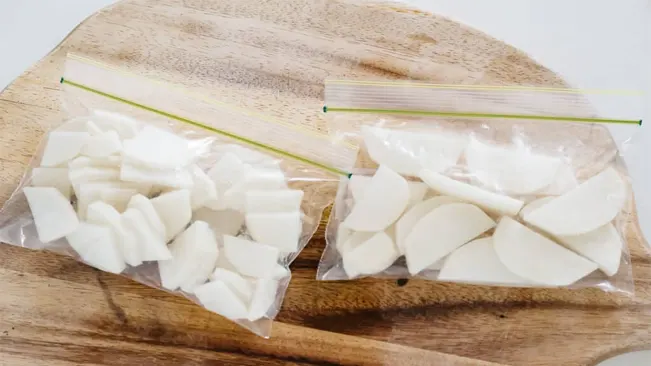
- Refrigeration: For use within a week or two, store Daikon radishes in the crisper drawer of your refrigerator. Wrap them in a damp paper towel and place them inside a perforated plastic bag to maintain humidity while allowing excess moisture to escape.
- Hydration: If the radishes begin to lose their crispness, you can rehydrate them by soaking in cold water for a few hours before use.
Long-Term Storage
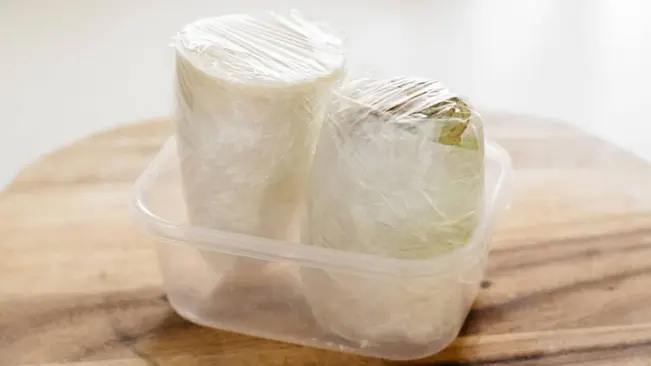
- Root Cellar or Cool Basement: For longer storage, a root cellar or a cool, dark basement is ideal. Maintain a temperature around 32-40°F (0-4°C) with high humidity.
- Sand Storage: Bury the radishes in moist sand in a container, ensuring they do not touch each other to prevent rotting. This method can extend their freshness for several months.
- Plastic Wrap: Alternatively, you can wrap each radish in plastic wrap and store them in a box in a cool, dark place. The plastic wrap helps retain moisture within the radish.
Signs of Spoilage
- Visual and Tactile Checks: Inspect stored radishes regularly for signs of spoilage, such as soft spots, mold, or an off-odor. Remove and discard any that are not in good condition to prevent the spread of spoilage to others.
Usage Tips
- Gradual Consumption: Store radishes of varying sizes together and use the larger ones first, as they tend to not last as long as the smaller ones.
- Reviving Radishes: If radishes become slightly soft or dehydrated, they can often be revived by soaking in ice water for a few hours to restore their crunchiness.
Pest and Disease Management
Pest Management
Flea Beetles:
- Description: Small, jumping beetles that feed on the leaves, creating small holes.
- Management: Use floating row covers to prevent beetles from accessing the plants. Diatomaceous earth or neem oil can be applied as natural deterrents. Keep the garden area free of weeds and debris where beetles might overwinter.
Root Maggots:
- Description: Larvae of a fly that feed on the roots, causing the plants to become stunted or wilt.
- Management: Apply beneficial nematodes to the soil to target maggot larvae. Crop rotation is essential to prevent the buildup of pests in the soil. Avoid excessive organic matter like manure, which can attract flies.
Disease Management
Clubroot:
- Description: A soil-borne fungal disease that causes swollen, distorted roots, leading to stunted growth.
- Management: Maintain a soil pH around 7.2 to make the environment less hospitable to the pathogen. Rotate crops with non-brassicas (plants not in the cabbage family) for at least 3-4 years. Remove and destroy infected plants.
Downy Mildew:
- Description: A fungal disease that causes yellow patches on the leaves, which can turn brown and lead to leaf loss.
- Management: Ensure good air circulation around the plants and avoid overhead watering to keep foliage dry. Use fungicides if necessary, following organic practices whenever possible.
Conclusion
Growing daikon radish can be a straightforward and rewarding endeavor for gardeners of all levels. By selecting the right variety, preparing the soil adequately, and providing regular care, you can enjoy a bountiful harvest of this versatile and flavorful vegetable. Remember, the key to successful daikon cultivation lies in attention to detail and responsiveness to the plants’ needs throughout the growing season. Enjoy the fruits of your labor in salads, soups, pickles, and more!
FAQs (Frequently Asked Questions)
- What is the best season to plant Daikon radishes?
- Daikon radishes are typically planted in late summer to early fall in cooler climates, as they prefer the cooler temperatures of fall for maturation. In warmer climates, an early spring planting is also possible.
- Daikon radishes are typically planted in late summer to early fall in cooler climates, as they prefer the cooler temperatures of fall for maturation. In warmer climates, an early spring planting is also possible.
- How deep should I plant Daikon radish seeds?
- Daikon radish seeds should be sown about ½ inch deep in the soil.
- Daikon radish seeds should be sown about ½ inch deep in the soil.
- What kind of soil is best for growing Daikon radishes?
- They thrive in loose, well-drained soil rich in organic matter. The soil should be deep enough (at least 12-18 inches) to accommodate the long roots, with a pH level of 6.0 to 7.0.
- They thrive in loose, well-drained soil rich in organic matter. The soil should be deep enough (at least 12-18 inches) to accommodate the long roots, with a pH level of 6.0 to 7.0.
- How much space do Daikon radishes need to grow?
- Space the seeds 2-4 inches apart in rows, and thin the seedlings to about 6 inches apart once they’ve grown a few inches tall to allow enough room for the roots to develop.
- Space the seeds 2-4 inches apart in rows, and thin the seedlings to about 6 inches apart once they’ve grown a few inches tall to allow enough room for the roots to develop.
- How often should I water Daikon radishes?
- Water regularly to keep the soil consistently moist but not waterlogged. They require steady moisture, especially during dry spells, to grow smoothly without splitting.
- Water regularly to keep the soil consistently moist but not waterlogged. They require steady moisture, especially during dry spells, to grow smoothly without splitting.
- Do Daikon radishes need a lot of sunlight?
- Yes, they prefer full sunlight but can tolerate partial shade. However, less sunlight may result in slower growth.
- Yes, they prefer full sunlight but can tolerate partial shade. However, less sunlight may result in slower growth.
- How long does it take for Daikon radishes to mature?
- Daikon radishes typically mature in 50-70 days, depending on the variety.
- Daikon radishes typically mature in 50-70 days, depending on the variety.
- What are common pests and diseases that affect Daikon radishes, and how can I manage them?
- Common pests include flea beetles and root maggots. Floating row covers can help prevent these pests. Rotate crops and avoid planting in the same spot to reduce disease risk.
- Common pests include flea beetles and root maggots. Floating row covers can help prevent these pests. Rotate crops and avoid planting in the same spot to reduce disease risk.
- How do I know when Daikon radishes are ready to harvest?
- Daikon radishes are ready when they are firm, and the skin is smooth. The top of the root may protrude from the soil, making it visible.
- Daikon radishes are ready when they are firm, and the skin is smooth. The top of the root may protrude from the soil, making it visible.
- Can I leave Daikon radishes in the ground after they mature?
- It’s best to harvest Daikon radishes once they mature, as leaving them in the ground too long can lead to a decline in quality. They may become woody, overly spicy, or split if left in the ground for too long after reaching maturity.

Kristine Moore
Forestry AuthorI'm Kristine Moore, a seasoned garden landscaping professional with over 30 years of experience. My extensive career has been dedicated to transforming outdoor spaces into stunning, sustainable landscapes. With a deep understanding of horticulture, design principles, and environmental stewardship, I have become a respected figure in the field, known for creating harmonious, visually appealing, and eco-friendly gardens. My commitment to excellence and continuous learning in landscaping trends and techniques has solidified my reputation as an expert in garden design and implementation.



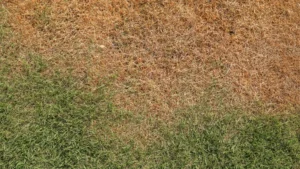









Leave your comment